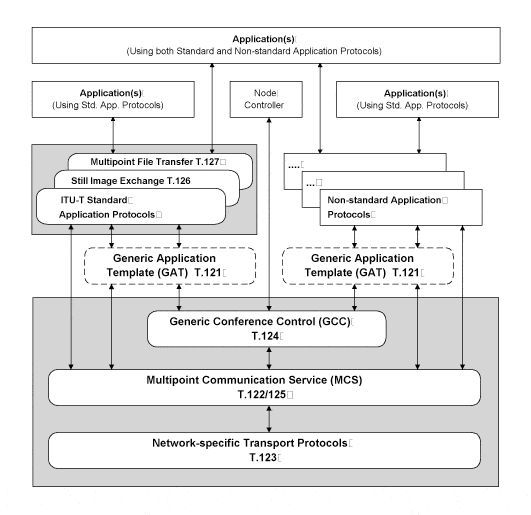Definition of T.120 Standard in Network Encyclopedia.
What is T.120 Standard?
T.120 Standard is an umbrella standard representing a suite of eight International Telecommunication Union (ITU) standards that define how real-time multipoint communication for tasks such as data conferencing and interactive game playing takes place over a network.

The standards define such things as:
- Multipoint services for conferencing
- Standard network services
- Guidelines for defining data channels
- Whiteboard methodologies
- Application-sharing protocols
- File transfer methodologies
T.120 is a multilevel standard that is tuned for reliable transmission within high-bandwidth enterprise environments running TCP/IP and other standard connection types. T.120 is the standard suite of protocols that makes possible collaboration and conferencing software such as Microsoft NetMeeting and is supported by many other telecommunications providers and application vendors.
How T.120 Standard Works
The architecture of the T.120 standard follows that defined by the 7 layers OSI Model for networking. The T.120 architecture can be divided into two parts:
- Network-layer and transport-layer standards (T.122 through T.125):Allow data to be transmitted and received between conferencing nodes over a variety of supported network connections. These standards also provide platform independence and the capacity for simultaneously managing multiple participants running on different operating system platforms and conferencing software.
- Application-layer standards (T.126 through T.128):Support multiuser conferencing functions such as whiteboarding, file transfer, and application sharing across different platforms and networks.
The following table shows the details of the various standards included under the T.120 umbrella.
T.120 Suite of Conferencing Standards
| Standard | Description |
| T.121 | A required standard for T.120 applications that defines how conference nodes register themselves with a T.120 node controller. Also defines the generic application template (GAT) for building T.120 application protocols and management facilities. |
| T.122 | Defines multipoint communication services (MCS) over various topologies to enable multiple participants to send data as part of a conference. The MCS defined by T.122 are implemented by T.125. |
| T.123 | Defines flow control, error control, and sequencing mechanisms for connect, disconnect, send, and receive functions over different network connections. |
| T.124 | Defines how multipoint conferences are initiated and administered, and defines the generic conference control (GCC) that manages and monitors users, address lists, data flow, and MCS resources. |
| T.125 | Defines how data is transmitted during a conference, specifying the private and broadcast channels that transport conference data. T.125 implements the MCS defined by T.122. |
| T.126 | Defines mechanisms for transmitting and receiving whiteboard information between conference nodes and manages the multiuser whiteboard workspace. |
| T.127 | Defines mechanisms for file transfer between conference nodes in either broadcast or directed mode. |
| T.128 | Defines mechanisms for application sharing between conference nodes so that users can share their local programs with others for collaborative purposes. |
T.120 and Remote Desktop Protocol
T.120 also forms the basis of the Remote Desktop Protocol (RDP), which is used in Microsoft Windows NT Server, Terminal Server Edition, and in Terminal Services of Microsoft Windows 2000 Advanced Server.
Co-existence with Other Standards
T.120 was designed to work alone or within the larger context of other ITU standards, such as the H.32x family of video conferencing standards. T.120 also supports and cross-references other important ITU standards, such as V.series modems.
Scalability
T.120 is defined to be easily scalable from simple PC-based architectures to complex multi-processor environments characterized by their high performance. Resources for T.120 applications are plentiful, with practical limits imposed only by the confines of the specific platform running the software.